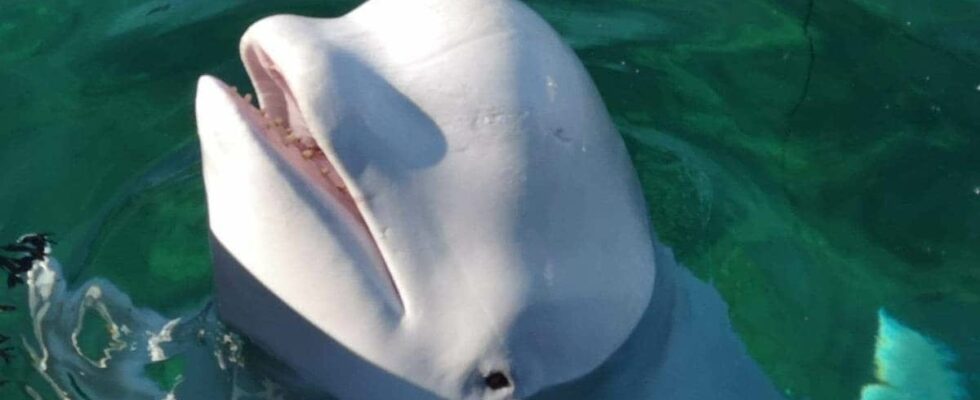The final autopsy report from the Veterinary Institute is now ready. – The veterinary institute’s investigations are made difficult by the fact that many of the whale’s organs were very rotten, says Amund Preede Revheim, head of the North Sea and environment section in the Sør-West police district. The report concludes that the cause of death is probably a bacterial infection. This is probably as a result of a wound in the mouth from a stuck stick. The background for the report to the police was photos of damage to the dead whale. A thorough examination of the whale has been carried out, the police state in a press release. – There is nothing in the investigations to indicate that Hvaldimir was killed illegally. The police therefore see no reason to start an investigation into the whale’s death, and the report received has been dismissed, says Revheim. This is what Hvaldimir looked like when it was found outside Tananger in Sola on 31 August. The whale had several holes in its body. Photo: Odd Rune Kyllingstad / news Hvaldimir was believed to have been shot On Saturday 31 August, Hvaldimir was found dead in the sea outside Tananger in Rogaland. The whale had several holes in its body and the organizations OneWhale and Noah believed it was highly likely that it had been shot and killed. But in the preliminary autopsy report in early September, there was no indication that the whale had been shot, police said. The same conclusion is reached in the final report on Friday. Several superficial skin wounds were found in the areas of the posterior chest cavity, abdomen, one forward crank and at the tail fin. The wound edges on these were uneven and torn, and they are interpreted as injuries caused by birds pecking holes in the skin, the report states. Hvaldimir was lifted out of the water after it was found dead in the sea. Photo: Odd Rune Kyllingstad / news On the underside of the whale there were two holes in the skin. The one wound went through the skin and the entire blubber layer, but did not affect internal organs. Assessments made by the Veterinary Institute and the police’s forensic technicians are that these are not gunshot wounds. An X-ray of the chest and head was carried out without projectiles or other metal fragments being detected. Can’t rule out gunshot wounds Siri Martinsen is head of the animal welfare organization Noah. She says it still cannot be ruled out that Hvaldimir may have died as a result of human influence. – The autopsy report has no clear cause of death. There is no indication that the wound through the blubber is a wound from birds or parasites – and the autopsy report does not say this either, she says. Martinsen says they will request access to all material surrounding the autopsy report. – There is still a suspicion that the whale has died as a result of human influence – both the stick and the circular unexplained wounds provide grounds for this. It would also be desirable if the whole whale had been X-rayed, she says. – Hvaldimir has inspired – I am happy that so much work has been done on this and that you have now received a final answer, says marine biologist Sebastian Strand in Marine Mind. He has worked with the whale for a number of years. – We are going to continue working with the dissemination of knowledge about marine life. Hvaldimir inspired us, he says. Marine biologist in the non-profit organization Marine Mind, Sebastian Strand. Photo: Odd Rune Kyllingstad / news Stick in the mouth A 35 centimeter long and 3 centimeter wide stick was found stuck inside Hvaldimir’s mouth. – The autopsy showed that his stomach was empty. In addition, most organs had broken down. There is nothing in the investigations that have been carried out to establish that it is human activity that has directly led to Hvaldimir’s death. This was said by the head of the North Sea and environment section at the joint intelligence and investigation unit in the Sør-West police district, Amund Preede Revheim. Common with holes on dead whales Professor of arctic and marine biology at UiT, Audun Rikardsen, has previously explained to news that the type of holes found on Hvaldimir are not unusual on dead whales. – Birds are quick to peck holes in whales, and they do the pecking in areas where the skin is weak. It can also be caused by a type of parasite that burrows into the whale’s skin. Whale researcher at the University of Tromsø, Audun Rikardsen. Photo: Torkil Stoltz / news When a whale dies, gas is produced in the stomach. As part of the putrefaction, the whale increases in volume. As it is raised, the pressure increases. Then these small holes will open, burst and begin to bleed. – He probably played with that stick and got it in his throat. Published 04.10.2024, at 08.46 Updated 04.10.2024, at 13.46
ttn-69
The autopsy report for Hvaldimir is ready – news Rogaland – Local news, TV and radio

